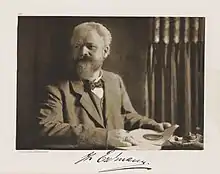Hugo Erdmann
Hugo Wilhelm Traugott Erdmann (8 May 1862 – 25 June 1910) was the German chemist who discovered, together with his doctoral advisor Jacob Volhard, the Volhard-Erdmann cyclization. In 1898 he was the first who coined the term noble gas (the original noun is Edelgas in German).[1]
Hugo Erdmann | |
|---|---|
 Hugo Erdmann | |
| Born | 8 May 1862 |
| Died | 25 June 1910 (aged 48) |
| Nationality | German |
| Known for | Volhard-Erdmann cyclization |
| Scientific career | |
| Doctoral advisor | Jacob Volhard |
Erdmann invented the name Thiozone in 1908, hypothesizing that S3 made up a large proportion of liquid sulfur.[2]
In collaboration with Rudolph Fittig, Erdmann found that dehydration of γ-phenyl structural analog of isocrotonic acid produced α-naphthol, an observation that provided evidence in understanding the nature of naphthalene.[3]
Bibliography
Books written by Erdmann:
- Hugo Erdmann (2009-01-31). Introduction to Chemical Preparations. BiblioLife. ISBN 978-0-559-91368-6.
See also
References
- "Hugo Erdmann". Archived from the original on 2007-10-17.
- Lockemann, Georg (1959), "Hugo Erdmann", Neue Deutsche Biographie (in German), vol. 4, Berlin: Duncker & Humblot, pp. 572–572
Notes
- Renouf, Edward (1901-02-15). "Noble gases". Science. 13 (320): 268–270. Bibcode:1901Sci....13..268R. doi:10.1126/science.13.320.268.
- Hugo Erdmann (1908). "Ueber Thiozonide, ein Beitrag zur Kenntniss des Schwefels und seiner ringförmigen Verbindungen". Justus Liebigs Annalen der Chemie. 362 (2): 133–173. doi:10.1002/jlac.19083620202.
- Fittig, Rudolph; Erdmann, Hugo (1883). "Synthese des α-Naphtols" [Synthesis of α-Naphtol]. Ber. Dtsch. Chem. Ges. (in German). 16 (1): 43–44. doi:10.1002/cber.18830160115.
This article is issued from Wikipedia. The text is licensed under Creative Commons - Attribution - Sharealike. Additional terms may apply for the media files.